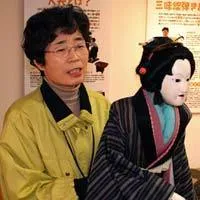Ningyo Joruri - Puppet Theatre
Written by

By Renee Liang
During the Japanese feudal period, puppet theatre became very popular in the countryside around Tokushima. Nearly every village had its troupe of puppeteers, and these groups often toured to surrounding areas, setting up after displaying their boxes of gear in the village square to arouse excitement. The stories often featured local folk heroes and classic themes of betrayal, loyalty, unrequited love and family commitment. These days, community puppet troupes still perform excerpts from the most popular plays, and 'Awa Puppet Theatre' is taught in schools as a 'living traditional art'. By Renee Liang
During the Japanese feudal period, puppet theatre became very popular in the countryside around Tokushima. Nearly every village had its troupe of puppeteers, and these groups often toured to surrounding areas, setting up after displaying their boxes of gear in the village square to arouse excitement. The stories often featured local folk heroes and classic themes of betrayal, loyalty, unrequited love and family commitment. These days, community puppet troupes still perform excerpts from the most popular plays, and 'Awa Puppet Theatre' is taught in schools as a 'living traditional art'.The puppets are nearly life-size, painstakingly carved out of wood. There are few craftsmen today who can make authentic puppets. The heads are fitted with a complex system of pulleys and switches which make the puppet capable of eye, mouth and eyebrow movement, and sometimes other visual tricks (such as transforming from a young woman to a devil).
I interviewed a puppeteer who performs at the Jurobei residence, an Edo-period house which has been set up as a puppet museum and showcase.
How long do you have to train to be a puppeteer?
At least three months to get the basic movements right. Because there are three people operating each puppet, we have to learn to step around each other and coordinate our actions so that each movement is lifelike. To get good enough to perform, you need at least three years.
Can anyone learn to be a puppeteer, or do you need to come from a certain background?
These days, yes. It isn't restricted to sex, or age. The young people are encouraged to learn through school, and some of them join clubs or community troupes. Most of them don't continue though. It is only much later, when they are less busy with their jobs and families, that they come back to it.
In the old days, you had to come from certain villages to be part of that village's troupe. There are still lots of regional troupes that perform.
What skills do you need?
The ability to work closely with a small team, to watch each other so you coordinate and don't step all over each other. You also have to coordinate with the narrator who reads the script, and the musical accompaniment by shamisen. Patience to practise over and over to get the necessary subtlety of movement - all the movements, the hand for example, have to look natural. You need a good eye to capture those.
Can you explain the main workings of the puppet?
There are defined roles for each of the three operators. The first person operates to head (controlling movement of the eyes, eyebrows and mouth with levers) and the right hand. They have to be strong, because they hold up the puppet and wear special tall clogs for extra height. The second operates the legs. The third operates the left hand.
I've heard that Ningyo Joruri is different to Bunraku theatre (one of the three treasured performance art forms, along with Noh and Kabuki). Can you tell me about the differences?
Well, first of all Bunraku was performed in the city for aristocrats while Ningyo Joruri was performed mainly in the countryside for farmers. So the subject matter is more "popular" rather than "artistic", and the language is more conversational, though still old-sounding to today's ears. Our plays often have more characters and more dramatic storylines so that people keep watching. The artists in Ningyo Joruri are more likely to be amateurs, whereas Bunraku artists are often professionals.
Secondly, Ningyo Jururi was meant to be performed outdoors, so the puppets have subtle changes so they have more impact. The heads are bigger, they often have brighter ornamentation, and the neck meets the head at more of an angle to enable wider head movements.
How many different stories are there?
There are 41 plays commonly performed, in whole or in part. Most troupes will only perform one or two scenes from a play now. Most of the plays are from the Edo period, and cover historical scenes. There are modern plays too though. For example one that was performed at last year's festival was by a Tokushima novelist, and it was written in modern colloquial language. That was a little difficult to perform as it didn't follow the usual rhythms of the old language of the other plays. I'm excited though that people are still writing plays for puppet theatre. I really hope it doesn't die out!!
Many thanks to Mihoko Teshigawara for her help with arranging the interview and translating, and to the Awa Puppet Museum of Tokushima.
Related story
Use the comment box below
16/01/09